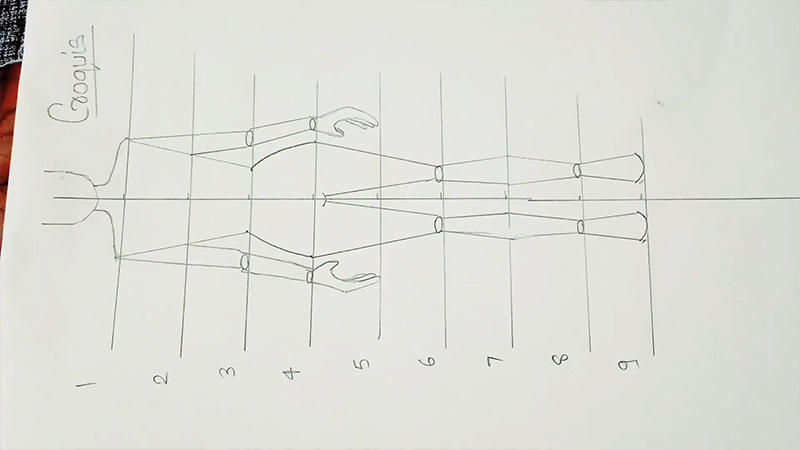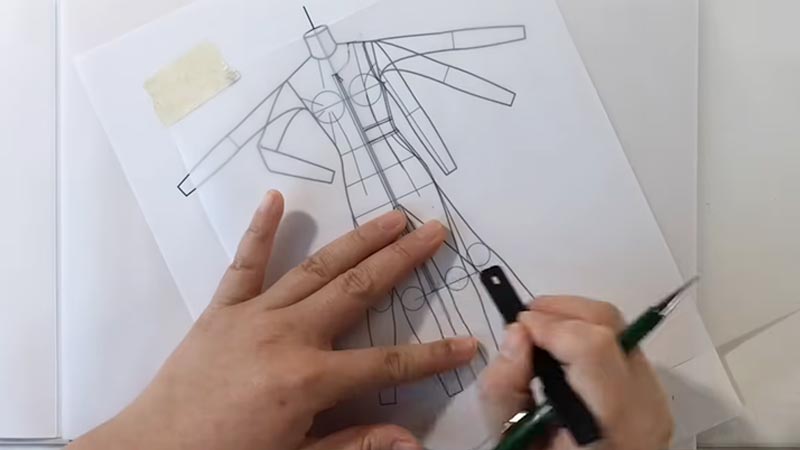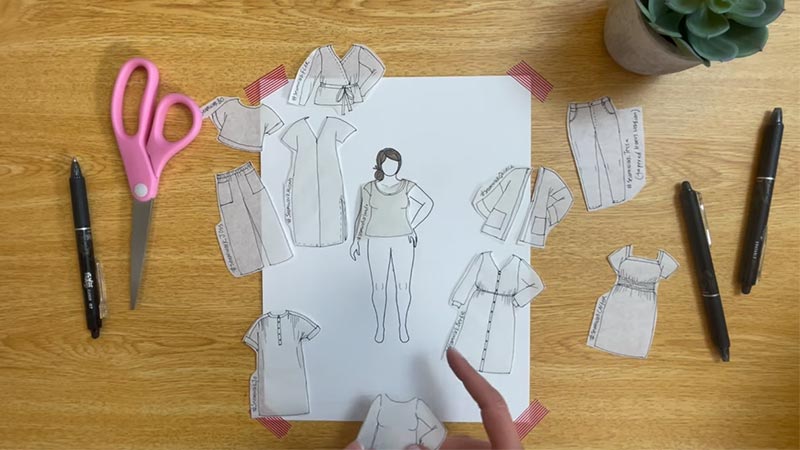In the realm of sewing and fashion design, a croquis is a fundamental and versatile tool used to bring the creative visions of designers to life.
Derived from the French word “croquis,” which means “sketch” or “rough drawing,” a croquis is essentially a simplified, elongated sketch of a human figure.
It serves as a blank canvas for fashion designers and sewists to visualize and plan their garment creations. With proportions typically set at 8 to 10 “heads” tall, the elongated figure of the croquis accentuates the garments being designed.
This introduction sets the stage for a deeper exploration of how this humble sketch plays a crucial role in fashion, from concept to creation.

History of Croquis in Sewing
The history of croquis in sewing is a journey that highlights the evolution of a vital tool in fashion design and garment creation. Croquis, which originated from the French word for “sketch,” has played a pivotal role in the development of the fashion industry:
Early Fashion Illustration
The origins of croquis can be traced back to early fashion illustration. In the 18th and 19th centuries, fashion plates became popular, featuring intricate fashion designs. These plates often included elongated, simplified figures, or croquis, to showcase the latest clothing trends.
Role in Fashion Design
In the 20th century, croquis became an integral part of fashion design. Designers recognized their value as a canvas for sketching and experimenting with various design elements. The elongated proportions of the croquis emphasized the visual impact of the clothing.
Design Presentations
Croquis also found a significant role in design presentations. The simplicity of these figures, devoid of facial features and distractions, made them ideal for showcasing fashion collections and design concepts. They allowed designers to convey their ideas clearly and elegantly.
Transition to the Digital Age
With the advent of digital technology, croquis evolved from traditional paper sketches to digital templates. Designers and fashion students could now access and customize digital croquis templates, making the design process more versatile and efficient.
Modern-Day Significance
Today, croquis continue to be a fundamental tool in sewing and fashion design. They help designers visualize their creations, maintain accurate proportions, and experiment with styles, fabrics, and colors.
This simple yet versatile tool has come a long way from its early fashion illustration roots, remaining an essential resource for designers and sewists in the modern fashion industry.
What Is A Croquis In Sewing?

In sewing, a croquis is a simplified, elongated sketch of a human figure, devoid of facial features and hair, used as a visual template for designing clothing. Typically around 8 to 10 “heads” tall, the croquis’s elongated proportions emphasize the garment’s design.
It provides a canvas for fashion designers and sewists to visualize and plan their creations accurately, ensuring proper proportions and fit.
Customizable to match the wearer’s body shape or measurements, the croquis aids in sketching garment outlines, adding details like seams and embellishments, and experimenting with various styles, fabrics, and colors.
It’s a valuable tool for problem-solving and making design decisions before the actual sewing process begins.
What Are the Practical Uses of a Croquis in Sewing?

A croquis, a simplified human figure sketch, is a versatile tool in the world of sewing and fashion design. Its practical uses are manifold, aiding in various aspects of the design and sewing process.
Here’s a breakdown of its practical applications:
Visualizing Clothing Designs
A croquis provides a human canvas for designers to visualize and conceptualize clothing designs. By sketching garments on a croquis, designers can see how they will look when worn, helping them assess proportions, fit, and overall aesthetics.
Designing Garments Accurately
Croquis ensures that design elements are accurately represented in terms of length, width, and fit. Designers can sketch and experiment with different necklines, sleeve lengths, hemlines, and other design elements. This leads to well-conceived designs.
Problem-Solving and Decision-Making
Croquis is a valuable tool for identifying and addressing design challenges before the actual sewing process begins. Designers can make adjustments and refinements to resolve issues, saving time, resources, and potential frustration.
Garment Drape and Fabric Flow
Designers can use croquis to visualize how the fabric will drape and interact with the body. This is especially important for designs involving draping, as it allows designers to foresee how the fabric will flow and how the garment will move when worn.
Experimentation
Croquis enables designers to experiment with different styles, cuts, and silhouettes. They can try out various design variations on the croquis to see what works best for their intended project.
Color and Fabric Choices
Croquis serves as a platform to experiment with color schemes and fabric choices. Designers can apply colors and textures to see how different fabrics and colors will look on the final garment.
Presentation
In design presentations, croquis are used to convey the concept and aesthetics of a clothing line or collection to clients, colleagues, or potential buyers. It’s a clear and professional way to showcase design ideas.
Creative Expression
Croquis encourages designers to express their creativity and artistic vision. They can add personal touches to the croquis, such as specific poses, facial features, or hairstyles, to bring their designs to life.
Efficiency
Using a croquis saves time and resources compared to creating full prototypes. It allows designers to quickly visualize and refine ideas before proceeding with the actual construction of the garments.
How to Sketch a Croquis for Sewing? Learn How!

Sketching a croquis for sewing is a fundamental skill for fashion designers, sewists, and clothing illustrators. A croquis serves as the foundation for visualizing and planning clothing designs.
Here’s a step-by-step guide on how to sketch a croquis for your sewing projects:
Gather Your Materials
Start by gathering the necessary materials. You’ll need a large sheet of paper, a pencil, an eraser, and markers or colored pencils if you want to add details and color. Alternatively, you can work digitally using design software or a drawing tablet.
Determine Proportions
Understand that a typical croquis is about 9-10 “heads” tall, which is taller than the average human proportion. This elongation is used to emphasize the clothing and create an elegant look. However, you can adjust the proportions to suit your design goals and preferences.
Sketch the Central Line
Begin by drawing a vertical line on your paper. This line represents the central axis of the body and helps maintain balance and proportion in your croquis.
Add Key Points
Draw horizontal lines at specific key points along the central line:
- Top of the head
- Shoulders
- Bust
- Waist
- Hips
- Knees
- Ankles
Outline the Body
Connect these key points with flowing lines to outline the body. Pay attention to the proportions and elongation of the figure to achieve a fashion-forward look.
Basic Facial Features and Hair
At the top of your croquis, sketch a simple oval for the head and add a neck. You can include basic facial features like eyes, nose, and lips or leave the face blank. Draw a hairstyle to complete the look.
Arms and Legs
Sketch the arms and legs, making sure they reach the mid-thigh area for the arms and the ankles for the legs. You can adjust the pose to match your design concept.
Hands and Feet
Add simplified hands and feet, but avoid going into too much detail. Basic shapes are sufficient to suggest the pose and style.
Garment Design
Use your croquis as a canvas to sketch your garment designs. Add details such as necklines, sleeve lengths, hemlines, and other design elements. Experiment with different styles, fabrics, and color combinations to bring your design to life.
Refine and Add Details
After sketching your initial design, use markers or colored pencils to add shading, texture, and color to your croquis. This step helps you visualize the final look of the garment more accurately.
Practice and Experiment
Creating a croquis is a skill that improves with practice. Experiment with different poses and styles, and don’t be afraid to make changes as you refine your croquis. Over time, you’ll become more proficient in creating croquis that accurately represent your design ideas.
FAQs
Can I use digital tools for creating a croquis in sewing?
Yes, digital design software and drawing tablets are often used to create croquis. These tools offer flexibility and the ability to easily edit and experiment with various design elements.
Is there a difference between male and female croquis in fashion design?
Croquis can be adapted to represent both male and female figures. Designers can choose croquis templates that suit the gender of their designs and tailor their clothing accordingly.
Are there different croquis styles for various fashion designs?
Yes, croquis can be customized to match the wearer’s body shape or the design goals. Different styles of croquis can be used to suit specific fashion design concepts, from casual to haute couture.
What is the role of technology in modern croquis creation?
Technology has made croquis creation more versatile. Many designers use digital tools and software to create and customize croquis, allowing for easy edits, experimentation, and a digital workflow.
How can I use croquis for pattern making in sewing and fashion design?
Croquis are invaluable for pattern making as they provide a visual reference for the initial shape and proportions of the garment. They aid in translating design ideas into precise patterns for cutting and sewing.
To Recap
The croquis stands as an unsung hero in the world of sewing and fashion design. It is the blank canvas upon which creativity and precision converge to bring stunning garment ideas to life.
With its elongated proportions and featureless form, it ensures that the spotlight remains squarely on the artistry of clothing design.
From visualizing concepts and refining details to assessing fit and fabric flow, the croquis offers a versatile and invaluable tool for designers.
It paves the way for efficient problem-solving, confident decision-making, and the creation of garments that not only fit beautifully but also embody the designer’s unique vision.
In this realm of stitches and style, the croquis reigns as a silent but indispensable partner in the creative journey.
Leave a Reply